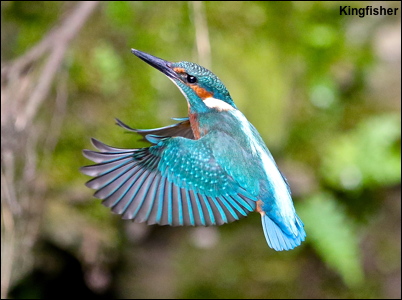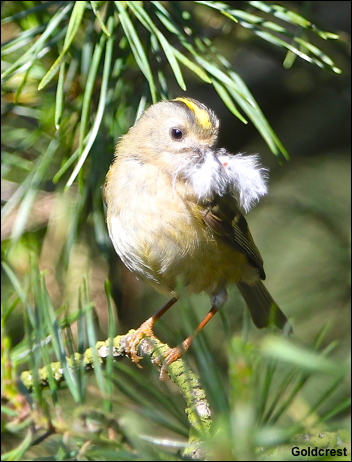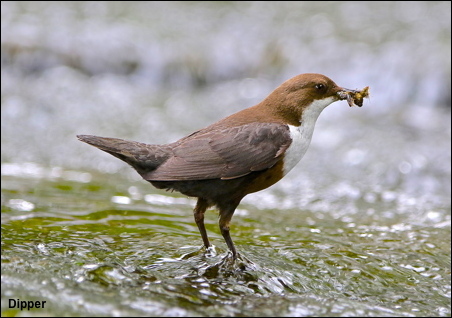August 27, 2016 at 6:42 pm

As a result of the flooding on Boxing Day last year two of my three regular Kingfisher sites have been washed away and with them the Kingfishers that had occupied these sites for more than thirty years. So it was to my third choice site, deep in the heart of Bowland, that I went this year for my photos.
As I sat in my hide in the river I was taken back to the very first Kingfisher I filmed in 1973 which was only a hundred yards or so from my present position. I was disturbed on that day by a pack of hounds that were working their way up the river searching for Otters! Thankfully Otter hounds have been banned years ago and today Otters and Kingfishers are more plentiful than they were in the halcyon days of yesteryear.
In the 43 years since those first Kingfishers I have spent more than a thousand hours in my hides taking photos and film. You might say that there is nothing new to film but you would be wrong. Every session in a hide could potentially produce unique pictures and an event occurred at this latest Kingfisher that I have never witnessed before.
As I sat waiting for the second brood of young to make their first flight from the tunnel two fledged young from the first brood re-appeared. They flew backwards and forwards to the tunnel entrance and pecked the earth around the hole as if they were helping the second brood to emerge. This lasted for an hour and I managed to obtain photos of them as they came within range of the camera.Click here
It made no difference to the latest young and they fledged the following day when I was on holiday!!
August 20, 2016 at 2:12 pm
 More than sixty years ago when I was learning about bird-watching from my father he used to mention this tiny bird which he called a Golden-Crested Wren. At the time my Observers Book of Birds made no mention of this bird and it was some years later when I had a more detailed bird-book that I discovered that the bird he praised so much was in fact a Goldcrest. It is our smallest bird and builds a delicate nest hanging under pine branches which it lines with feathers. It is a very rare moment to encounter Goldcrests lining their nests with feathers but a few weeks ago I was lucky and took some photos of this seldom seen event. Click here
More than sixty years ago when I was learning about bird-watching from my father he used to mention this tiny bird which he called a Golden-Crested Wren. At the time my Observers Book of Birds made no mention of this bird and it was some years later when I had a more detailed bird-book that I discovered that the bird he praised so much was in fact a Goldcrest. It is our smallest bird and builds a delicate nest hanging under pine branches which it lines with feathers. It is a very rare moment to encounter Goldcrests lining their nests with feathers but a few weeks ago I was lucky and took some photos of this seldom seen event. Click here
August 13, 2016 at 3:02 pm

After weeks of entries from Scotland and Spitsbergen it is good to get back to the local scene and the Pennines.
In the last decade Dippers are regularly breeding through into July, something that was unheard of in the past. It would be nice to think this late breeding was second broods but that may not necessarily be so. With flooding more regular these days it may well be that these late breeding attempts are in fact replacements for earlier lost nests. Click here
Over the garden on the 11th were a pair of Buzzards with two of this years young. Along the local canal was the first Kingfisher of late summer.
August 7, 2016 at 3:42 pm

This weeks blog photo is of a female Hen Harrier returning to her nest with nesting material and is my favourite photo from my work this year and coincides with today’s National Hen Harrier day. I attended the Bowland meeting which re-iterated the appalling fact that only one pair of Hen Harriers this year nested on an English Grouse moor and reared just one young. Conservative estimates state that there should be at least 300 pairs nesting in England. The reason for the shortfall is that they have all been shot by gamekeepers to increase the number of Red Grouse available to be shot by the landowners clients who can pay as much as £5000 per gun for a days shooting.
DEFRA and ENGLISH NATURE have chosen to ignore this persecution and Mark Avery has started a National Petition to ban driven Grouse moors in an attempt to stop the persecution of Hen Harriers.
I would urge all readers of my blog to sign this petition on and check his web-site for more detailed information as to what is happening on our local Grouse moors. https://petition.parliament.uk/petitions/125003
The gallery this week contains the photos taken in Speyside last week and includes a young Mountain Hare. Click here



 More than sixty years ago when I was learning about bird-watching from my father he used to mention this tiny bird which he called a Golden-Crested Wren. At the time my Observers Book of Birds made no mention of this bird and it was some years later when I had a more detailed bird-book that I discovered that the bird he praised so much was in fact a Goldcrest. It is our smallest bird and builds a delicate nest hanging under pine branches which it lines with feathers. It is a very rare moment to encounter Goldcrests lining their nests with feathers but a few weeks ago I was lucky and took some photos of this seldom seen event.
More than sixty years ago when I was learning about bird-watching from my father he used to mention this tiny bird which he called a Golden-Crested Wren. At the time my Observers Book of Birds made no mention of this bird and it was some years later when I had a more detailed bird-book that I discovered that the bird he praised so much was in fact a Goldcrest. It is our smallest bird and builds a delicate nest hanging under pine branches which it lines with feathers. It is a very rare moment to encounter Goldcrests lining their nests with feathers but a few weeks ago I was lucky and took some photos of this seldom seen event. 
